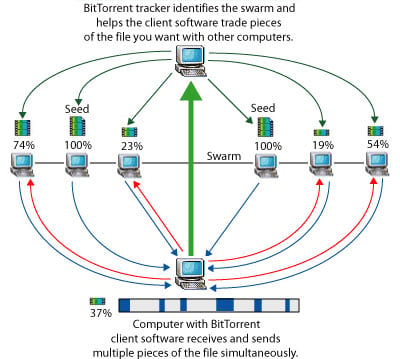
The History of BitTorrent: What To Know
BitTorrent was a protocol created by Bram Cohen in 2001 to share large computer files over the internet. Cohen was frustrated by the long wait times to download large files on the existing peer-to-peer services which led to the invention of BitTorrent. Files shared with this protocol were divided into small fragments for distribution among users, called ‘peers’. The protocol was recognized for its efficient utilization of bandwidth. The first implementation of the BitTorrent client was released on July 2nd’ 2001. This software is now managed by Cohen’s company, BitTorrent Inc. This data-sharing tool has made many people happy (free music, movies, and software!).
The Founding of BitTorrent: How It Happened
In 2001 an American computer programmer, named Bram Cohen, began his work on a protocol and a program, which will change the entertainment industry and the interchange of information in Web. The peer-to-peer (P2P) protocol was named BitTorrent, as well as the first file sharing program to use the protocol, also known as BitTorrent.

Bram Cohen was born in 1975 in New York in a Jewish family, and grew up in Manhattan’s Upper West Side, where his father taught him the basics of computer coding at age 6. In first grade, he flummoxed friends with comparisons of the Commodore 64 vs. the Timex Sinclair personal computers, and was actively programming by age 10. Cohen graduated from Stuyvesant High School and later attended for 2 years State University of New York at Buffalo. In 1995 he decided to drop out of college, bored out of his mind, he said, to work for several dot-com companies throughout the mid to late 1990s, the last being MojoNation, an ambitious but ill-fated project.
MojoNation allowed people to break up confidential files into encrypted chunks and distribute those pieces on computers also running the software. If someone wanted to download a copy of this encrypted file, he would have to download it simultaneously from many computers. Cohen found this concept as perfect for a file sharing program and protocol, since programs like the popular then KaZaA take a long time to download a large file because the file is (usually) coming from one source.
That’s why Cohen designed BitTorrent to be able to download files from many different sources, thus speeding up the download time, especially for users with faster download, than upload speeds, which is the case with the vast majority of users. Thus, the more popular a file is, the faster a user will be able to download it, since many people will be downloading it at the same time, and these people will also be uploading the data to other users.
In April 2001, Cohen quit MojoNation and began work on BitTorrent. He wrote the first BitTorrent client implementation in Python language, and several other programs have since implemented the protocol.
BitTorrent gained its fame for its ability to quickly share large music and movie files online. Cohen himself has claimed he has never violated copyright law using his software and initially he designed it for the community at etree.org, a site that shares only music by artists who expressly allow the practice. It however didn’t take long for the software to take hold with illegal music and movie swapping.
How Does It Work?
BitTorrent is a protocol that offloads some of the file tracking work to a central server (called a tracker). Another basic rule is that it uses a principal called tit-for-tat, which means that in order to receive files, you have to give them. This solves the problem of leeching, which was one of developer Bram Cohen’s primary goals. With BitTorrent, the more files you share with others, the faster your downloads are. And as it was already mentioned, to make better use of available network bandwidth (the pipeline for data transmission), BitTorrent downloads different pieces of the file you want simultaneously from multiple computers.

To download a file with BitTorrent, you have open a Web page and click on a link for the file you want. BitTorrent client software communicates with a tracker to find other computers running BitTorrent, that have the complete file (so called seed computers) and those with a portion of the file (peers that are usually in the process of downloading the file).
The tracker identifies the swarm, which is the connected computers that have all of or a portion of the file and are in the process of sending or receiving it.
The tracker helps the client software trade pieces of the file you want with other computers in the swarm. Your BitTorrent client receives multiple pieces of the file simultaneously.
If you continue to run the BitTorrent client software after your download is complete, others can receive .torrent files from your computer and your future download rates improve because you are ranked higher in the tit-for-tat system.
By 2004, Cohen formed BitTorrent, Inc., with his brother Ross Cohen and business partner Ashwin Navin.
Soon P2P network BitTorrent became extremely popular. According to some estimations, in 2004 its traffic represented from 20 to 35% of all traffic on the Internet.
Due to his principle of contacting many (up 300-500 servers per second) BitTorrent lead to the interesting network issue. Routers that use NAT (Network address translation), must maintain tables of source and destination IP addresses and ports. Typical home routers are limited to about 2000 table entries while some more expensive routers have larger table capacities. As BitTorrent frequently contacts many servers per second, it rapidly fills the NAT tables, causing home routers to lock up.
Another “copyright related” issue is that, as the BitTorrent protocol provides no way to index torrent files, comparatively small number of websites have hosted a large majority of torrents, many linking to copyrighted material, rendering those sites especially vulnerable to lawsuits.
BitTorrent: Through The Decades
2001-2011 / Phase 1
BitTorrent was a company was founded in 2001 by Bram Cohen. It was an excellent way to share large filed over the internet by dividing them into small fragments and sending it via a peer-to-peer network by reassembling them. Initially, the company started on a great and unique idea, people were loving it. Cohen was recognized for founding one of the most important tools, and surely there was business to be made from it.
However, from the start, BitTorrent had a branding problem. Since it was open-source, pirates used it to transfer movies illegally, and the company couldn’t do anything about it. BitTorrent also made efforts to turn into a media company, and by 2007, they launched BitTorrent Entertainment Network. The BitTorrent Entertainment Network was a storefront for music and movies and failed to make any money which is why it had to shutdown a year later.
2011-2021 / Phase 2
In 2013, the company launched the BitTorrent Bundle, a competitor to Amazon and iTunes. This platform let the artists distribute their songs directly to their fans. Additionally, the company also decided to come up with their own show ‘Children of the Machine’ in 2014, but didn’t move forward with this plan. BitTorrent has remained a technology that has been in search of business for years. A lot of factors have contributed in the collapse of the company.
How Did BitTorrent Make Money?
BitTorrent’s executives, founders and investors have tried to find out various money-making strategies over the past years, which include both entertainment business and enterprise software. While BitTorrent has been used to conduct illegal activity, it is just a really good tool that could be used to do great things. Around 170 million people used BitTorrent every month, as per the company website. It was also used by Twitter and Facebook to distribute updates to their servers.
BitTorrent Acquisitions
Acquisition by Justin Sun
BitTorrent has faced many challenges throughout. It was acquired by a Chinese millionaire Justin Sun. He was the founder of a cryptocurrency company in Beijing called Tron. Tron was working on a similar philosophy of decentralization, just like BitTorrent, hence, it looked like a fit.
BitTorrent: Notable Controversies
There has been much controversy over the use of BitTorrent trackers. BitTorrent metafiles themselves do not store copyrighted data. Whether the publishers of BitTorrent metafiles violate copyrights by linking to copyrighted material is controversial. Various jurisdictions have pursued legal action against websites that host BitTorrent trackers. High-profile examples include the closing of the trackers Suprnova.org, Torrentspy, LokiTorrent, Demonoid, Mininova and OiNK.cd.
The Pirate Bay torrent website, was noted for the “legal” section of its website in which letters and replies on the subject of alleged copyright infringements are publicly displayed. In 2006 the Pirate Bay’s servers in Sweden were raided by Swedish police on allegations of copyright infringement, the tracker however was up and running again three days later.